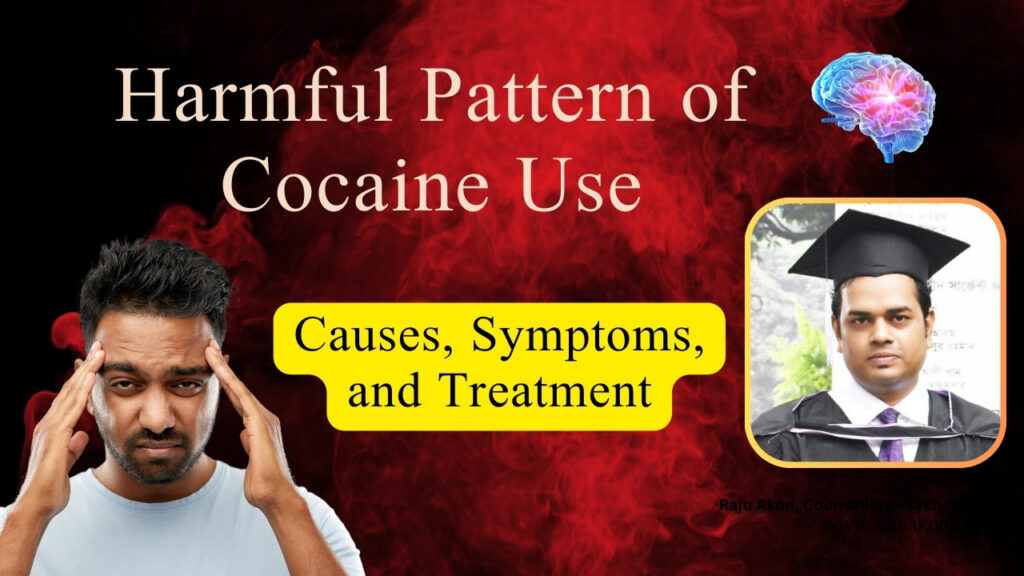Cocaine is a deficient stimulant drug derived from the coca plant, usually used recreationally for its euphoric effects. However, it has enormous addictive, and its misuse can create severe physical, mental, and social consequences. In this article, we will define the harmful pattern of cocaine use, its symptoms, and possible treatment options.
What is the Harmful Pattern of Cocaine Use?
The harmful pattern of cocaine use refers to a form of substance abuse where the user continues consuming the drug despite significant negative consequences. Cocaine abuse affects the brain’s reward system, leading to addiction, and over time, the user may find it increasingly difficult to control their intake despite facing physical and psychological harm.
Causes of Cocaine Use
Various social, psychological, and biological factors often influence the initiation of cocaine use:
- Peer Pressure: Friends or social circles that encourage drug experimentation can influence an individual’s decision to try cocaine.
- Stress and Mental Health Issues: People dealing with anxiety, depression, or trauma may turn to cocaine to numb their emotional pain or enhance their mood.
- Genetics: A family history of substance abuse may increase the likelihood of developing cocaine dependency.
- Environment: Exposure to environments where drug use is normalized increases the risk of addiction.
Symptoms of Cocaine Abuse
identifying the symptoms of cocaine misuse is crucial for timely intervention. These symptoms can manifest in various forms:
- Physical Symptoms:
- Dilated pupils
- Increased heart rate and blood pressure
- Weight loss due to decreased appetite
- Frequent nosebleeds (in case of snorting)
- Restlessness and insomnia
- Behavioral Symptoms:
- Aggressiveness or mood swings
- Risky behaviors such as unusual sex or driving under the influence
- Financial issues due to the cost of sustaining the habit
- Frequent absences from work or school
- Psychological Symptoms:
- Anxiety and paranoia
- Hallucinations and delusions
- Depression during withdrawal periods
- Loss of interest in activities once enjoyed
Long-term Effects
Prolonged cocaine abuse can lead to severe health complications such as:
- Cardiovascular problems: Increased risk of heart attacks and strokes.
- Respiratory issues: If smoked, it can damage the lungs.
- Neurological damage: Prolonged use affects the brain, leading to cognitive impairments.
- Mental health disorders: Anxiety, depression, and psychosis are common.
Treatment for Cocaine Addiction
While overcoming cocaine addiction can be challenging, several treatment facilities are known to help individuals heal:
- Behavioral Therapies:
- Cognitive-behavioral therapy (CBT): Helps individuals recognize and change harmful thinking processes and behaviors related to drug use.
- Contingency Management: Offers incentives or rewards for abstaining from drug use.
- Motivational Interviewing: Encourages patients to build the motivation needed to quit.
- Medication-Assisted Treatment (MAT):
- At present, there are no exact medications authorized for treating cocaine addiction. However, some drugs used for other purposes, like antidepressants or anticonvulsants, may be prescribed to ease withdrawal symptoms and reduce cravings.
- Inpatient and Outpatient Rehabilitation:
- Inpatient Rehab: Provides a structured, drug-free environment where individuals receive intensive therapy and medical care.
- Outpatient Rehab: Offers more flexibility, allowing a person to resume their daily energies while attending therapy.
- Support Groups:
- Participation in 12-step programs like Narcotics Anonymous can provide ongoing support during recovery, helping individuals stay accountable and connected to others in similar situations.
Prevention and Early Intervention
Preventing cocaine abuse starts with education and early intervention. Public awareness campaigns, school programs, and family-based interventions can help people, especially young adults, understand the risks associated with cocaine use. Encouraging open conversations about drug use and addressing any early signs of abuse can prevent more severe patterns from developing.
Conclusion
Cocaine abuse can lead to devastating physical, mental, and social consequences, but recovery is possible. Through a combination of behavioral therapies, support groups, and rehabilitation programs, individuals can regain control of their lives and break free from addiction. Early intervention and seeking help are crucial to minimizing the long-term damage caused by cocaine use.

